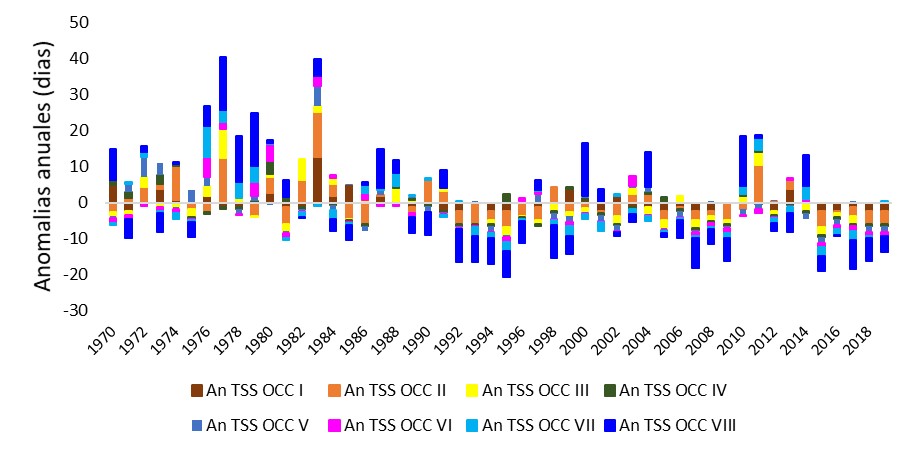Synoptic climatology in Cuba. Part 5: The relationships between atmospheric circulations and the types of synoptic situations
Main Article Content
Abstract
The study analyzed the behavior, changes, and current trends in atmospheric circulation processes influencing North America and Cuba, under the already perceptible effects of climate change. To this end, long series of daily data on the Elementary Circulation Mechanisms of the Northern Hemisphere and the Regional Circulation Processes influencing North America and Cuba were used, as well as, the Catalog of Synoptic Situation Types influencing the western and eastern halves of Cuba from 1970 to 2019. The results show important statistical relationships between these three groups of variables, demonstrating the close physical interrelationship of synoptic processes, operating from global and regional to local scales. The multiannual, seasonal and regional behaviors of the relationships between these circulation processes and the synoptic situations that influence Cuba are described, demonstrating that some relationships show persistent changes and increasing trends, which can be interpreted as the response of the atmospheric circulation to the impact of the forcing caused by the global warming process, which is statistically evident from specific change points, identified between the years 1992 and 2002. Finally, it is demonstrated that there is a marked and well-defined seasonal different genesis from the relationships between the circulation processes and the synoptic situations that influence the western and eastern halves of Cuba.
Downloads
Article Details

This work is licensed under a Creative Commons Attribution-NonCommercial 4.0 International License.
Those authors who have publications with this journal accept the following terms of the License Attribution-NonCommercial 4.0 International (CC BY-NC 4.0):
You are free to:
- Share — copy and redistribute the material in any medium or format
- Adapt — remix, transform, and build upon the material
The licensor cannot revoke these freedoms as long as you follow the license terms.
Under the following terms:
- Attribution — You must give appropriate credit, provide a link to the license, and indicate if changes were made. You may do so in any reasonable manner, but not in any way that suggests the licensor endorses you or your use.
- NonCommercial — You may not use the material for commercial purposes.
- No additional restrictions — You may not apply legal terms or technological measures that legally restrict others from doing anything the license permits.
The journal is not responsible for the opinions and concepts expressed in the works, they are the sole responsibility of the authors. The Editor, with the assistance of the Editorial Committee, reserves the right to suggest or request advisable or necessary modifications. They are accepted to publish original scientific papers, research results of interest that have not been published or sent to another journal for the same purpose.
The mention of trademarks of equipment, instruments or specific materials is for identification purposes, and there is no promotional commitment in relation to them, neither by the authors nor by the publisher.
References
Dzerdzeevskii, B.L. (1968). Los mecanismos de la circulación de la atmósfera en el hemisferio norte en el siglo XX [en ruso]. Resultados de Investigaciones durante el Año Geofísico Internacional. Circulación Atmosférica. Ed. Instituto Geografía, A.C. de la URSS, Moscú.
Hoel, P. (1972). Introducción a la Estadística Matemática. Ed. Revolucionaria, 471 p.
Lapinel, B. (1987). La circulación atmosférica y las características espacio-temporales de las lluvias en Cuba [inédito]. Tesis en opción del grado de Dr. en Ciencias Geog. Instituto de Meteorología, La Habana; 147 p.
Lecha, L. (2018). Biometeorological forecasts for health surveillance and prevention of meteor-tropic effects. Inter. Jour. Biomet., Special Issue, 62(5): 733-740. DOI 10.1007/s00484-018-1544-0.
Lecha, L., Soler, E., Sánchez, L. y Verdecia, Y. (2024a). La Climatología Sinóptica en Cuba. Parte 2: El Catálogo de los tipos de situaciones 1970-2022. Rev. Cub. Meteorología, 30(1): enero-marzo. ISSN 2664-0880.
Lecha, L., Soler, E., Sánchez, L., Verdecia, Y. y Roura, P. (2024b). La Climatología Sinóptica en Cuba. Parte 3: Características climáticas de los grupos, tipos y subtipos de situaciones (1970-2022). Rev. Cub. Meteorología, 30(2), abril-junio. ISSN: 2664-0880.
Roura, P., Arenas, J. C., Sistachs, V. y Díaz, D. (2020). TrendSoft: Software para el análisis de tendencia y puntos de cambio de variables climatológicas. Rev. Cub. Meteorología, 26(3), julio-septiembre: 1-16. ISSN: 2664-0880.
Rodríguez, R. J. (2004). Ayudas SPSS. Chi-cuadrado. Notas Metodológicas. 19 p.
https://academia.edu/keypass/Ayuda_SPSS_Chi_cuadrado_Notas_Metodologicas
Sávina, S.S. y Khmelevskaya, L.V. (1984). La Circulación de la Atmósfera. Dinámica de los procesos de la circulación atmosférica durante el siglo XX [en ruso]. En: Materiales de las Investigaciones Meteorológicas, 9. Ed. Comité Geofísico de la URSS e Instituto Geografía, AC de la URSS, Moscú, 116 p.
Soler, E., Sánchez, L., Lecha, L. y Verdecia, Y. (2020). Los mecanismos elementales de circulación en América del Norte y su relación con las situaciones sinópticas que influyen sobre la mitad occidental de Cuba. Rev. Cub. Meteorología, 26(sp): 1-18. ISSN: 2664-0880.
Soler, E., Lecha, L. y Roura, P. (2025). Comportamiento de los procesos regionales de la circulación atmosférica que influyen sobre América del Norte desde finales del siglo XIX. Rev. Cub. Meteorología, 31(2), abril-junio, 1-12. ISSN: 2664-0880.

